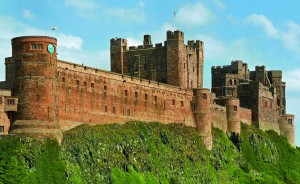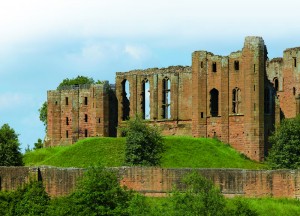

A new generation of castleologists believe that castles were about much more than trebuchets, portcullises, galloping hooves, boiling oil, and the clash of swords on armour: instead, castles were centres of lordship, symbols of wealth, and expressions of status, alluding to the past and expressing poetic ideals. Chris Catling reports.
Forget what you were taught at school about castles being military buildings: new research, pulled together in a massive new volume The English Castle by John Goodall, suggests that they are primarily residences, stately homes that used military references, such as moats, towers, and battlements, as statements of power and prestige; and that the architectural trappings of fortification continued to be used to define aristocratic dwellings right up to the eve of the English Civil War. It was then, ironically, that many castles saw the only combat they ever experienced, shortly afterwards to be decommissioned as part of a campaign of republican zeal.
Even in its ruined state, Dunstanburgh Castle is one of England’s most impressive and inspiring castles: sitting on a spectacular headland between the villages of Craster and Embletonon the Heritage Coast of Northumberland, Dunstanburgh presents a powerfully romantic vision of rock, sea, and castle turret silhouetted against the northern sky. Built on a massive scale, the castle fell into disrepair at the end of the Middle Ages, and was a popular subject for 19th century topographical artists.
There is evidence that Dunstanburgh was made more romantic by19th-century owners through selective demolition, designed to open up particular views and to give a more pleasing and sculpted appearance to the shape of the ruins.
So it comes as something of a shock to discover that Dunstanburgh might always have been intended to look like a mythical fantasy castle: that when the castle was built in the second decade of the 14th century by Thomas Earl of Leicester and Lancaster (1278–1322), the wealthiest nobleman in England at the time (and leader of the baronial revolt against his own cousin, King Edward II), he might have had visual effect and literary allusion as much in mind as military necessity.
Indeed, one has to ask what exactly is the castle doing here at all, in an otherwise empty landscape, and what exactly is it defending? A team ofarchaeologists, led by Alastair Oswald, surveyed and excavated the site in 2003, and think they have an answer.
They discovered that the earthworks surrounding the castle were not Medieval at all, but formed the ramparts of an Iron Age promontory fort, raising the possibility that these prominent prehistoric earthworks – quite possibly themselves the subject of Medieval speculation and myth, associating them with mighty rulers and warriors of the past – might have been the reason why Thomas of Lancaster chose the site for his castle.
Source from : http://www.archaeology.co.uk/news-features/the-english-castle.htm
For more interesting topics related to archaeology, visit archaeology excavations.
No comments:
Post a Comment